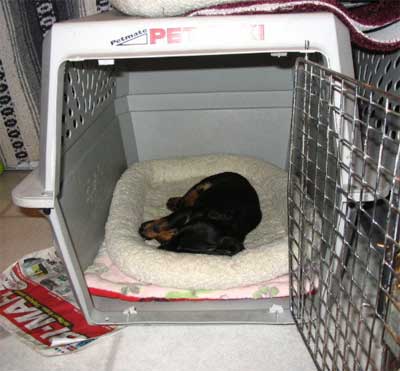Charlotte Peltz Living with Your Dog "House Training ... an Ongoing Project" brought to you by Joy Beckner Artist/ Bronze Sculptor
Living with Your Dog
House Training ... an Ongoing Project
Notes from breeder Miki Perry
"I think the main key is crate training.

I start [crate training] my puppies at around 7-9 weeks as they are being slowly weaned. I let my bitches decide when that happens.
First I split the litter into 2 crates for a night or so, then 2 or 3 to a crate.
My puppies don't leave until at least 12 weeks so I have 4-5 weeks to get their crate training pretty much under control.
I put the pups outside just before I am ready for bed, around 9:30 - 10 o'clock. They are allowed enough time to do their thing and then they are brought inside and put into crates with their siblings. It doesn't take but 2-3 nights and they are holding it until I take them out between 5-6 A.M. Rarely do mine cry in the night but if they do I get up and put them outside for a bit.
During the day my pups are either outside in a pen (a large one) or inside in a double-triple x-pen with papers on one side. They have a soft bed in one corner and their water in another. And, of course, toys. And, I feed [puppies] 3-4 times a day.
They have their play time with the family inside and outside. I never take my eyes off of them and when the body language tells me that 'an event' is going to happen, outside they go.
They still wet on the papers for a long time but rarely do they do the big job as they cry and run around telling me they 'have to go now!' Of course they get a lot of praise for going outside.
It takes diligence and consistency and being with them most of the time to keep up the training. Not everyone is capable of doing this due to jobs and having a life other than their dogs.
By the time my pups are 12 weeks old they are sleeping in individual crates. If their new owners would just continue to use this training with a crate it would be so easy for them to finish their house training.
As we who love Dachshunds know, they are never 100% house trained except for that rare few. But they are trained, or have us trained, so we can live comfortably with them.
I deal with each pup as it comes. I tell my people the same thing and answer any questions they have and stress CRATES.
When my pups leave they are all crate trained so I don't get why they can't follow through. It is so easy to housetrain them when they are already crate trained. "It just takes being observant and consistent."
Observant and consistent even works with my old girl Lizzie. Lizzie came to me at age 6 ½ years, with a crate. It was the first time I had been exposed to a crate, but Lizzie knew exactly what to do with it. Much to my dismay, she felt safe in that crate. While we have two crates, we find that Lizzie and Edgar, both standards, fit just fine in one crate and do not complain about being too confined when we travel, or if we leave the house for an hour or two. Edgar's breeder assured me that a crate was the safest place to carry a dog when driving. Up close behind the front seat is best in case someone rear-ends your SUV. In addition to Miki's recommendations, safety while driving is another good reason to have a crate for your pup.
Thank you, Miki, for your thoughts and a picture of a happy pup in its crate. In case you are interested, attractive crates are available through a number of catalogs for those of you who prefer a functional and decorative crate. Enjoy! Joy
"One can measure the size and moral progress of a nation to how she treats her animals." Mahatma Gandhi.
Back to Charlotte Peltz List of Articles
Call Charlotte at 707-923-3477

